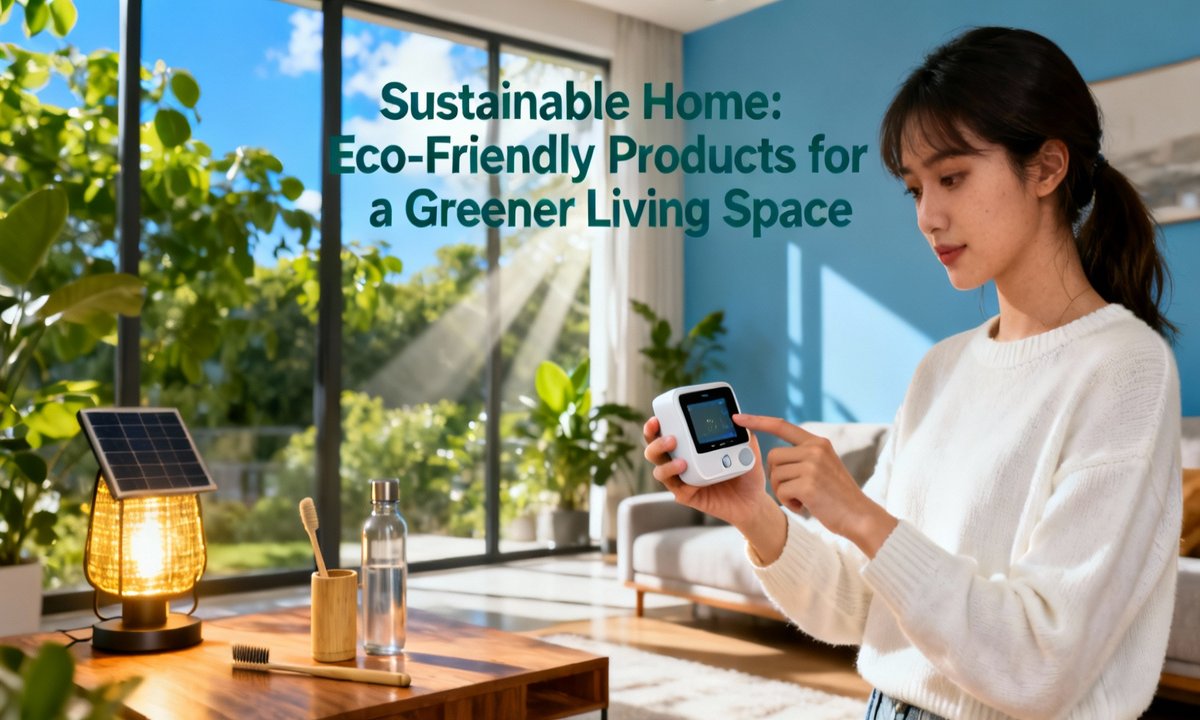Making your home eco-friendly in 2025 is more than a passing trend; it’s an achievable and impactful way to enhance daily living. From simple product swaps to significant upgrades, sustainability can seamlessly integrate into various lifestyles and budgets. Embracing these small changes can lead to substantial benefits for your family and the planet, helping you create a greener living space that truly reflects your values.
Why Embrace a Sustainable Home?
The growing emphasis on sustainable living arrives at a critical moment, as the visible effects of climate change and resource scarcity highlight its urgency. Fortunately, a wider array of affordable eco-friendly products now makes it easier for homeowners and renters alike to participate. Even younger buyers often prioritize sustainability when decorating and renovating their spaces.
Beyond conserving resources, eco-friendly home products can significantly improve indoor air quality, reduce utility bills, and foster a healthier environment for everyone. Modern home design increasingly features renewable materials, smart appliances, and responsibly sourced items, reflecting a collective move towards more conscious living and better home performance.
Essential Eco-Friendly Swaps
Making more sustainable choices often begins with the products used daily. Thoughtful swaps can effectively reduce waste, lower energy consumption, and even elevate your home’s aesthetic. Consider these practical changes to enhance your living space.
LED Lighting: Replacing traditional incandescent bulbs with LEDs is a highly effective change. These lights consume up to 90% less energy and boast a significantly longer lifespan, potentially saving hundreds of dollars annually for the average household. Exploring smart home upgrades for energy savings can provide further insights into intelligent lighting choices.
Insulated Curtains: Investing in thick, light-colored curtains can help regulate your home’s temperature all year. They effectively reduce heat loss during winter and block intense summer sun, keeping your interiors comfortable. High-quality insulated curtains are a top recommendation for energy-proofing your home in modern living environments.
Kitchen Swaps: Transitioning from plastic to stainless steel lunch boxes offers numerous benefits. They are non-toxic, exceptionally durable, dishwasher-safe, and designed to keep food fresh for longer. Complement these with bamboo utensils, reusable silicone food storage bags, and compostable sponges for a truly green and efficient kitchen.
Reusable Water Bottles: Opting for stainless steel or glass water bottles helps minimize plastic waste and ensures your drinks remain pure. These straightforward swaps provide daily convenience and form a fundamental part of cultivating a zero waste kitchen lifestyle.
Smart Induction Ranges: Modern induction cooktops, like advanced slide-in ranges, use significantly less energy compared to traditional gas ranges. These appliances offer superior efficiency, enhanced safety, and more consistent cooking results. If you are curious about upgrading appliances, consider exploring energy-efficient appliances for green living.
Compostable and Zero-Waste Solutions: Reducing landfill waste is achievable with home compost bins, biodegradable trash bags, and all-purpose cleaners in refillable packaging. Each refill or composted food scrap directly contributes to a healthier planet and a more sustainable home environment.
Smart Shopping for a Greener Lifestyle
When making purchases, prioritize products with minimal or no packaging to reduce waste. Always verify for trusted third-party certifications such as ENERGY STAR, FSC, or Fair Trade, which signify adherence to environmental and ethical standards. Many retailers now offer a growing selection of zero-waste and minimalist options to support conscious consumption.
Designing with Sustainability in Mind
Sustainability in home design is not about sacrifice but about making thoughtful choices that result in a beautiful and healthy living space. When refreshing your home, actively seek out eco-friendly materials and support brands committed to responsible practices.
Recycled or Renewable Materials: Incorporating rugs, pillows, and blankets made from recycled fibers or organic textiles can enhance your decor while reducing resource consumption. Additionally, integrating reclaimed wood or upcycled decor items can add unique character without generating new waste.
Enhance Indoor Air Quality: Introducing houseplants can provide a natural and effective boost to indoor air purification. Certain varieties, such as snake plants and pothos, are known to filter toxins, creating a healthier and more refreshing atmosphere within your home.
FSC-Certified Furniture: When selecting larger furniture pieces, look for brands that utilize FSC-certified wood or recycled metals. This certification guarantees that the wood originates from responsibly managed forests, ensuring minimal environmental impact. If you are working with a budget, explore inspiring DIY decor ideas to transform your space using upcycled or thrifted materials for creative, low-cost updates.
Key Investments for a Greener Home
While small adjustments create a strong foundation, making larger upgrades can significantly advance your home’s sustainability efforts. These substantial investments offer long-term benefits for both your property and the environment.
Solar Panels: Installing rooftop solar systems allows you to harness renewable energy, substantially decreasing your reliance on fossil fuels. In 2025, various incentives and financing options continue to improve, making solar power more accessible to a wider range of homeowners than ever before.
Energy Star Appliances: Upgrading older appliances to Energy Star-certified models can lead to dramatic reductions in both water and energy consumption. These efficient appliances are widely available and often offset their cost through savings over their operational lifespan. For more information, discover how to start cutting electric costs with smart appliances.
Sustainable Home Building or Renovation: For those planning new construction or significant renovations, consider options like modular or prefab green homes. These approaches can minimize waste, reduce costs, and integrate energy-efficient building materials for a truly sustainable living environment.
Navigating the Eco-Friendly Marketplace
Finding eco-friendly products has become more convenient than ever. Major online retailers, specialized zero-waste stores, and local boutiques now offer a diverse selection of sustainable choices. Always seek out items with clear third-party certifications, such as ENERGY STAR, FSC, or Fair Trade, which confirm adherence to rigorous environmental and labor standards.
The year 2025 has seen zero-waste and minimalist retail solutions become increasingly mainstream, including refillable bath products, compostable home goods, and items packaged with minimal or no plastic. For larger purchases and renovations, consulting the EPA Green Building Guidelines can help keep your project aligned with sustainable practices. Sustainable purchases do not always have to be expensive; explore how to save thousands with sustainable choices.
Cultivating Sustainable Daily Habits
Integrating sustainable habits into your daily life is often simpler than you might imagine, and every small effort contributes to a larger positive impact. Here are some proven steps to foster greener everyday living within your home.
Begin by consistently using reusable shopping and produce bags for all your errands, significantly reducing plastic waste. Consider starting a home composting system to effectively divert food scraps from landfills, turning them into valuable soil enrichment.
Installing low-flow showerheads and faucets throughout your home is an easy way to conserve water without sacrificing performance. Monitoring your energy use with smart meters or tracking apps can help identify areas for improvement and promote more mindful consumption.
Regularly decluttering and donating unused household items not only organizes your space but also supports reuse and reduces overall consumption. For assistance, explore our recommendations for essential home organization tools. Integrating these routines into your daily life reinforces your commitment to sustainability and amplifies your home’s positive environmental impact.
Future Perspectives on Green Living
The future of sustainable homes is dynamic and increasingly inclusive. Expect to see widespread adoption of smart home technology, continuously optimizing energy and water usage within residential spaces. You can learn more about this by reading about slashing your electric bill with smart upgrades.
Eco-friendly products are becoming available across all budget points, from luxury items to affordable options suitable for starter apartments. Consumers are increasingly demanding transparency, leading to more disclosures about carbon footprints, sourcing details, and ethical labor practices for home goods. Ultimately, sustainability is gaining status as a hallmark of both environmental stewardship and modern comfort.
Simple Steps to Sustainable Success
Starting small is key; even a single change, such as switching to reusable containers, can yield compounding benefits over time. Prioritize investing in quality items, as durable products last longer and help reduce overall waste, making them a more sustainable choice in the long run. Choose changes that seamlessly fit your existing lifestyle to ensure greater success and sustained adoption.
Top Eco-Friendly Product Recommendations
Consider these highly recommended eco-friendly products to easily integrate sustainability into your home. Stainless steel reusable lunch boxes and insulated water bottles made from steel or glass offer durable, waste-reducing alternatives for food and drink. Bamboo utensils and cutting boards provide sustainable kitchen options.
Smart induction kitchen ranges enhance cooking efficiency. Eco-friendly cleaning products in reusable or refillable packaging minimize plastic waste. LED bulbs and smart lighting systems significantly reduce energy consumption. Finally, recycled-fiber blankets and pillows, alongside compost bins and biodegradable trash bags, complete a comprehensive approach to a greener home.
Lasting Impact Through Conscious Choices
Adopting eco-friendly home products and habits offers a powerful way to contribute positively to the planet, all without compromising on style or comfort. Today, creating a sustainable home is both affordable and accessible, providing immense rewards for those who embrace it. Whether you are upgrading appliances, decluttering your space, or simply choosing better kitchen tools, every decision contributes to a greater impact.
If you are curious about where to begin your journey, explore our curated articles for more smart home upgrades for energy savings, discover creative DIY decor ideas, or find useful decluttering tips and tools to help transform your living space. Ready to make your home even greener? Dive deeper into the EPA Green Building Guidelines and join countless others embracing a cleaner, healthier future, one room at a time.




